
Using the Longe
Using the longe line has always been frustrating for me. I’ve seen 30 feet of line commonly used to send a horse in a circle around the handler, at various gaits. The trainer I worked with as a youngster did some of that, and then progressed to using two of these lines. Attached at each side of the halter and run through western stirrups, or perhaps a surcingle, the two lines provided the handler the ability to ground drive the horse, which was a pre-requisite to mounted work.
However, as far as I’m concerned, two thirty foot lines means sixty feet of rope to get tangled up in. I was little more than a hazard to myself and the horse at my mercy with two such lines at my disposal. In such times of entanglement I couldn't help but wonder, what is the point of sending a horse in a wide circle with one line? Or ask for direct rein responses from twenty foot away, with two lines? What do I or the horse gain from these particular exercises? When I’d ask others (and I asked many), the usual response would be, “Well, we do that to take the edge off him. He’s cold-backed.” Or maybe, “The horse is lazy. Work him on the line, so that he looks forward to the break you can offer when you ask him to stop.”
Longing in this way is regarded as a form of discipline, punishment, or a way of commanding the horse’s obedience, via the hand aids. If you have a horse with high energy, and you ask him to run in circles, before every ride…ummmm…aren’t you conditioning him, to become a more robust horse? What might begin as a five minute pre-ride longe soon becomes a ten minute, then 15, then 20 minute drill…you get the idea. If your horse is healthy, and you do this daily, you will in no time find yourself longing an hour for a half hour ride. Congratulations. You have an endurance prospect.
The other reasoning doesn’t make any more sense. Like a Kindergartener, the average healthy, young green start has boundless energy. Unless the horse is overweight, unsound, or underfeed, he is not looking for physical respites. He’s more often looking for mental ones. He might be looking for comfort, a reprieve from the attack, and indeed be glad to be asked to stop moving. But do we need to attack him in the first place, to make him appreciate the subsequent relief?
Even in the best of applications, as in teaching the direct rein in ground driving, I often wondered if there could be a safer, more effective way to gain the same experience, using less line. My concern centered on the idea of tact. Why communicate with a horse at the end of a thirty foot rope? That’s like having a conversation with a friend from across the gymnasium. Sure, it can be done, with a lot of yelling and gesturing, but it’s a frustrating and sometimes ineffective process. A lot of meaning can be lost, or misunderstood, when using such an inefficient means of communication. Sending a horse out on the end of a line is no different. It leaves a lot of room for miscommunication, misunderstandings to occur. Ambiguity is about the last thing a horse needs in the training process. Even a thin, lightweight line can become a heavy burden to the horse, when it provides unclear information about the handler’s request. Even a sensitive feel, a tactful hand, can listen and speak falsely from this distance.
However, as far as I’m concerned, two thirty foot lines means sixty feet of rope to get tangled up in. I was little more than a hazard to myself and the horse at my mercy with two such lines at my disposal. In such times of entanglement I couldn't help but wonder, what is the point of sending a horse in a wide circle with one line? Or ask for direct rein responses from twenty foot away, with two lines? What do I or the horse gain from these particular exercises? When I’d ask others (and I asked many), the usual response would be, “Well, we do that to take the edge off him. He’s cold-backed.” Or maybe, “The horse is lazy. Work him on the line, so that he looks forward to the break you can offer when you ask him to stop.”
Longing in this way is regarded as a form of discipline, punishment, or a way of commanding the horse’s obedience, via the hand aids. If you have a horse with high energy, and you ask him to run in circles, before every ride…ummmm…aren’t you conditioning him, to become a more robust horse? What might begin as a five minute pre-ride longe soon becomes a ten minute, then 15, then 20 minute drill…you get the idea. If your horse is healthy, and you do this daily, you will in no time find yourself longing an hour for a half hour ride. Congratulations. You have an endurance prospect.
The other reasoning doesn’t make any more sense. Like a Kindergartener, the average healthy, young green start has boundless energy. Unless the horse is overweight, unsound, or underfeed, he is not looking for physical respites. He’s more often looking for mental ones. He might be looking for comfort, a reprieve from the attack, and indeed be glad to be asked to stop moving. But do we need to attack him in the first place, to make him appreciate the subsequent relief?
Even in the best of applications, as in teaching the direct rein in ground driving, I often wondered if there could be a safer, more effective way to gain the same experience, using less line. My concern centered on the idea of tact. Why communicate with a horse at the end of a thirty foot rope? That’s like having a conversation with a friend from across the gymnasium. Sure, it can be done, with a lot of yelling and gesturing, but it’s a frustrating and sometimes ineffective process. A lot of meaning can be lost, or misunderstood, when using such an inefficient means of communication. Sending a horse out on the end of a line is no different. It leaves a lot of room for miscommunication, misunderstandings to occur. Ambiguity is about the last thing a horse needs in the training process. Even a thin, lightweight line can become a heavy burden to the horse, when it provides unclear information about the handler’s request. Even a sensitive feel, a tactful hand, can listen and speak falsely from this distance.

“Put an easy caveson upon the horse’s nose, and make him go forwards round you, standing quiet and holding the longe; and let another man, if you find it necessary, follow him with a whip. All this must be done very gently, and but little at a time: for more horses are spoiled by overmuch work, than by any other treatment whatever; and that by very contrary effects: for sometimes it drives them into vice, madness, and despair, and often stupefies and totally dispirits them.” A Treatsie Upon Horsemanship, Francois Roichon de la Gueriniere
The longe as described by De La Gueriniere is a cord, about the size of a little finger, and twelve feet long which attaches to the halter or caveson at the horse’s nose [other authors used more precise length, a rope to horse ratio, but for all practical purposes, 12 feet will do]. The short distance allows clarity and safety from entanglement, while still allowing the horse to move freely in each gait. The absence of a metal snap, hardware, allows the rope to maintain its lightweight feel, for the benefit of both the horse and the human. The location at the horse’s nose, however, offers the most benefits. The rope, from this position, not only allows the horse to feel the handler’s indication, but furnishes a visual aid as well. The rope at the nose allows the handler to suggest more precise positions, to elongate the spinal column, to collect; to elevate the head and neck, to lower. The attachment at the nose allows the horse and handler a richer, deeper dialogue than the attachment beneath the chin, and can more readily encourage the horse to explore a wide range of motion. This rope position allows the handler to request direct rein responses, indirect rein responses, rein back and forward movements from the horse, all while encouraging a position which makes each of these movements possible. In short, a full open dialogue can be enjoyed between the horse and handler from the safety of the ground, which can produce very clear, specific movements before the horse is even mounted. An educated equestrian can utilize the longe, and all these benefits, with a deeper understanding of the sensitive hand as the primary aid.
1.27.12 TME
return to
Educated Equestrian
return to
Educated Equestrian